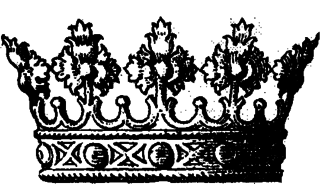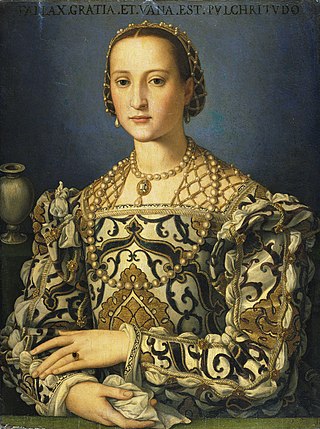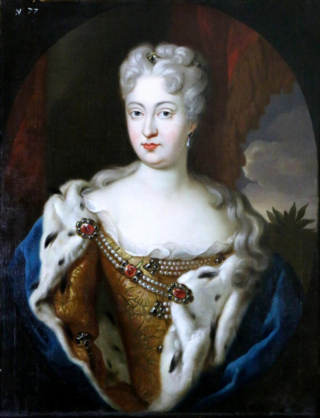
The House of Medici was an Italian banking family and political dynasty that first consolidated power in the Republic of Florence under Cosimo de' Medici, during the first half of the 15th century. The family originated in the Mugello region of Tuscany, and prospered gradually until it was able to fund the Medici Bank. This bank was the largest in Europe during the 15th century and facilitated the Medicis' rise to political power in Florence, although they officially remained citizens rather than monarchs until the 16th century.

Cosimo I de' Medici was the second duke of Florence from 1537 until 1569, when he became the first grand duke of Tuscany, a title he held until his death.

Anna Maria Luisa de' Medici was an Italian noblewoman who was the last lineal descendant of the main branch of the House of Medici. A patron of the arts, she bequeathed the Medicis' large art collection, including the contents of the Uffizi, Palazzo Pitti and the Medici villas, which she inherited upon her brother Gian Gastone's death in 1737, and her Palatine treasures to the Tuscan state, on the condition that no part of it could be removed from "the Capital of the grand ducal State....[and from] the succession of His Serene Grand Duke."

Gian Gastone de' Medici was the seventh and last Medicean grand duke of Tuscany.
Cosimo de' Medici (1389–1464) was the founder of the Medici family.

The Grand Duchy of Tuscany was an Italian monarchy that existed, with interruptions, from 1569 to 1860, replacing the Republic of Florence. The grand duchy's capital was Florence. In the 19th century the population of the Grand Duchy was about 1,815,000 inhabitants.

Cosimo III de' Medici was Grand Duke of Tuscany from 1670 until his death in 1723, the sixth and penultimate from the House of Medici. He reigned from 1670 to 1723, and was the elder son of Grand Duke Ferdinando II. Cosimo's 53-year-long reign, the longest in Tuscan history, was marked by a series of laws that regulated prostitution and May celebrations. His reign also witnessed Tuscany's deterioration to previously unknown economic lows. In 1723, when Cosimo died, he was succeeded by the younger of his two surviving children, Gian Gastone.

Cosimo II de' Medici was Grand Duke of Tuscany from 1609 until his death. He was the elder son of Ferdinando I de' Medici, Grand Duke of Tuscany, and Christina of Lorraine.

Francesco I was the second Grand Duke of Tuscany, ruling from 1574 until his death in 1587. He was a member of the House of Medici.

The Duca della Repubblica Fiorentina, rendered in English as Duke of the Florentine Republic or Duke of the Republic of Florence, was a title created in 1532 by Pope Clement VII for the Medici family, which ruled the Republic of Florence. There were effectively only two dukes of the Republic of Florence, Alessandro de' Medici and Cosimo de' Medici, the second duke being elevated to Grand Duke of Tuscany, causing the Florentine title to become subordinate to the greater Tuscan title.

Eleanor of Toledo was a Spanish noblewoman who became a Duchess of Florence as the first wife of Cosimo I de' Medici. A keen businesswoman, she financed many of her husband's political campaigns and important buildings like the Pitti Palace. She ruled as regent of Florence during his frequent absences: Eleanor ruled during Cosimo's military campaigns in Genoa in 1541 and 1543, his illness from 1544 to 1545, and again at times when the war for the conquest of Siena (1551–1554). She founded many Jesuit churches. She is credited with being the first modern first lady or consort.

Maria Maddalena of Austria was Grand Duchess of Tuscany by her marriage to Cosimo II in 1609 until his death in 1621. With him, she had eight children, including a duchess of Parma, a grand duke of Tuscany, and an archduchess of Further Austria. Born in Graz, Maria Magdalena was the youngest daughter of Charles II, Archduke of Inner Austria, and his wife Maria Anna of Bavaria. During the minority of her son, Grand Duke Ferdinando, she and her mother-in-law acted as regents from 1621 to 1628. She died on 1 November 1631 in Passau.

Joanna of Austria was an Archduchess of Austria. By marriage to Francesco I de' Medici, she was the Grand Princess of Tuscany and later the Grand Duchess of Tuscany. One of her daughters was Marie de' Medici, second wife of King Henry IV of France.

Princess Isabella Romola de' Medici was a Tuscan noblewoman and the daughter of Cosimo I de' Medici, first Grand Duke of Tuscany, and Eleonora di Toledo. Beautiful, intelligent, witty and refined, she is often referred to as the Star of the House of Medici, in recognition of "her playfulness, vibrancy, often sarcastic sense of humour, sharpness and interest in a huge variety of topics - not to mention the great parties she held". She received a humanist education alongside her brother, Francesco de' Medici, who succeeded their father as the Grand Duke of Tuscany. To secure Tuscany's southern borders via a relationship with the powerful Roman Orsini family, Isabella's father arranged her marriage to Paolo Giordano I Orsini when she was 16. At her father's behest, she remained in Florence after her marriage, affording her an unprecedented level of independence for a woman of her era.

Vittoria della Rovere was Grand Duchess of Tuscany as the wife of Grand Duke Ferdinando II. She had four children with her husband, two of whom would survive infancy: the future Cosimo III, Tuscany's longest-reigning monarch, and Francesco Maria, a prince of the Church. At the death of her grandfather Francesco Maria della Rovere, she inherited the Duchies of Rovere and Montefeltro, which reverted to her second son, Francesco Maria, at her death. She was later entrusted with the care of her three grandchildren. Her marriage brought a wealth of treasures to the House of Medici, which can today be seen in the Palazzo Pitti and the Uffizi Gallery in Florence.

Camilla Martelli was first the lover and then the second wife of Cosimo I de' Medici, Grand Duke of Tuscany. She was the mother of Virginia de' Medici, future Duchess of Modena.

Violante Beatrice of Bavaria was Grand Princess of Tuscany as the wife of Ferdinando de' Medici, Grand Prince of Tuscany and Governor of Siena from 1717 until her death. Born a Duchess of Bavaria, the youngest child of Elector Ferdinand Maria, she married the heir to the Tuscan throne, Ferdinando de' Medici, in 1689. Violante Beatrice loved him but Ferdinando did not return her affection, declaring her too ugly and too dull. Her brother-in-law, Prince Gian Gastone, befriended her out of sympathy, a friendship that lasted until Violante Beatrice's demise.

Eleonora di Garzia di Toledo or Leonor Álvarez de Toledo Osorio, more often known as "Leonora" or "Dianora", was the daughter of García Álvarez de Toledo, 4th Marquis of Villafranca, Duke of Fernandina. Leonora was born in Florence, where she was brought up by Cosimo I de' Medici, Grand Duke of Tuscany and his wife Eleanor of Toledo, her aunt and namesake. Betrothed to their son Pietro at the age of 15, she blossomed under the wing of Pietro's older sister, the artistic patron Isabella, into a vivacious and witty beauty. Her marriage, like Isabella's, was not a success, and she followed her mentor's example of taking lovers. For this reason, Pietro had her brought in 1576 to the country retreat of Cafaggiolo, where he strangled her to death with a dog leash. Cosimo's successor, Francesco I, tacitly approved the murder, and Pietro was never brought to justice for it.

Anna Maria Franziska of Saxe-Lauenburg was the legal Duchess of Saxe-Lauenburg in the eyes of the Holy Roman Emperor, the overlord of Saxe-Lauenburg, from 1689 until 1728; however, because her distant cousin George William, Duke of Brunswick-Lüneburg, conquered the duchy by force in 1689, she exercised no control over the territory, instead living in her manors in Bohemia.

Anna de' Medici was a daughter of Cosimo II de' Medici, Grand Duke of Tuscany and his wife Maria Maddalena of Austria. A patron of the arts, she married Ferdinand Charles, Archduke of Further Austria in 1646. They were the parents of Claudia Felicitas of Austria, Holy Roman Empress.


















